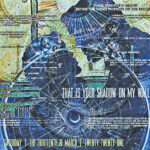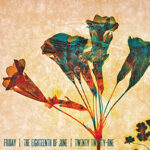Photo Courtesy of Gregory Parker
Although the pandemic has had many of us overwhelmed, even paralyzed, Gregory Parker leaped into action.
The “reformed scientist,” now a graphic designer, illustrator and photographer, began creating what would become “Distancing,” 489 digital collages that mark the days between March 23, 2020, and July 24, 2021. It’s now on exhibit at the Manitou Art Center.
The resulting images are layers upon layers of color, words, faces and much more, so complex it’s hard to believe Parker created them in just 10 to 15 minutes each morning. But the images had been simmering in his mind for decades.
“For many years, I had wondered why I was collecting images and if I would ever do anything with them. With this project, I had at least one answer,” Parker said from his home in Madison, Wisconsin.
“Additionally, I was amused that one reason I started the project, tracking the time spent social distancing, really did help me with the day and date! Finally, I felt a lot of anxiety and fear about the pandemic. Not for my health, but for my friends and family, and even the country and the planet some days.”

For about 20 years, he’d been telling himself that he had to organize his collection of images; he often spent more time looking for what he wanted to use than actually using them. Fortunately, the pandemic gave him some time to finally tackle that undertaking.
“Since I had to look at images multiple times, this process helped me make a mental list of the ‘right’ content for this project,” Parker said.
To create the images, he used Adobe’s Photoshop, Illustrator, InDesign and Lightroom, Microsoft Excel and “a few other esoteric plug-ins and pieces of abandonware (software that’s no longer marketed) that I try to use in experimental ways.”
Some of those experiments included using software designed to “stitch” together images to create a panorama — but he used unrelated images. Some incorporated paintings and collages he’s been working on, while others include images he created with a film camera and a darkroom.
And, of course, Parker drew on what was happening in the world.
“If I had already looked at the internet or listened to the morning news, bits and pieces of that information would find their way into the design. While working, I often listen to music, so fragments of song lyrics or memories related to specific songs would also make the occasional appearance,” he said.
The main reason he stopped last July 24 is because he doesn’t like using a laptop, and that weekend was the first time he’d be away from home for more than a day since the pandemic started.
The second reason stems from his emotions, ones he shares with so many of us.
“I was hopeful that the pandemic was close to being over, things would begin to feel normal again and I wouldn’t need the project. Since I was wrong about the pandemic being over, part of me wishes I had not stopped,” Parker said.
So how did a Wisconsin artist end up exhibiting his work in Manitou Springs, especially since, as he admits, he’s spent very little time in Colorado?
It goes back to his college days, when he started a friendship with Melanie Audet, a fiber artist who can often be found at the Manitou Art Center. She’d seen his Instagram version of the project and kept asking if he’d try to exhibit it somewhere.

A few months later, the images were accepted into a show called “Everything COVID” at the Overture Center for the Arts in Madison. And about that time, Audet told him there might be an open timeslot on the MAC’s exhibit schedule.
“I had a great experience at the MAC and really enjoyed meeting the people who work there and those I spoke with at the opening. It is an amazing place, and Manitou Springs is very fortunate to have it,” Parker said.
About that “reformed scientist” description: Parker admits that he added that to his biography to amuse the friends who were proofreading it. But he really does have a bachelor’s in biology from Albion College (Michigan) and a master’s in cellular and molecular biology from the University of Wisconsin-Madison.
“I wanted to do something ‘real’ and ‘pure’ with my life, something that was free of human bias and institutions, so studying nature seemed like an excellent way to do that.
“I later learned that I was a bit naïve and that everything people do has issues. So I decided to spend my short time here doing what made me happy and fulfilled and let the rest of it happen around me.”
Some of that fascination with nature has crept into these images. For instance, the image he created on June 18, 2021, depicts flowers of an unearthly sort. He also incorporates mathematical principles and imagery.
“The Universe is elegant and beautiful — I think about this often and want to share that feeling with my audience,” Parker said.
He still draws on his science background for other projects, such as a cover illustration for the Journal of Biomolecular Screening.
“Distancing” also includes some images that are autobiographical and deeply personal, so the exhibit is very close to his heart.
“In the past few years, I have started to think of my art as scenes from books I will never write, canvases I will never paint, songs I will never compose and movies I will never make. I’d love to be able to do all those things, but there are the big questions of time and talent,” Parker said.
On Jan. 1, 2022, he started another, similar project he’s calling “Omega” and posting on his Instagram account (www.instagram.com/gregoryparker_rekrapyrogerg). He’s not having quite as much fun with this one, though, which could be blamed on pandemic fatigue.
For now, “Distancing” is available for gallery visitors to enjoy and ponder.
“Since the moments I use from my life are often universal experiences and feelings, I hope to activate the memories of and inspire self-reflection in my audience. Because I also draw inspiration from topics that interest me and feel important, it would be a bonus if seeing work stimulated someone to explore these topics independently,” Parker said.

